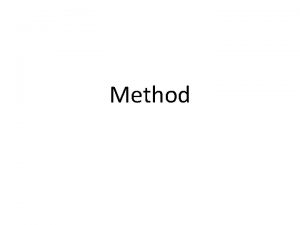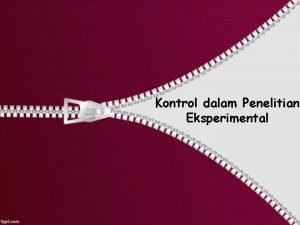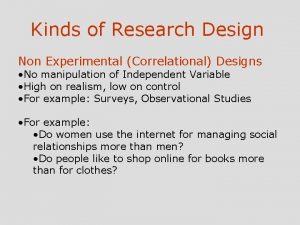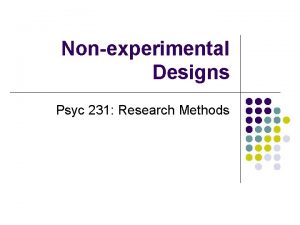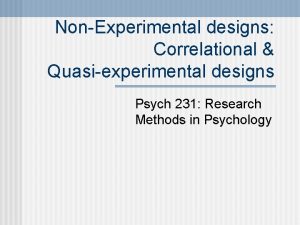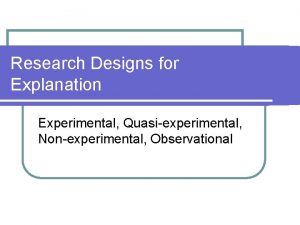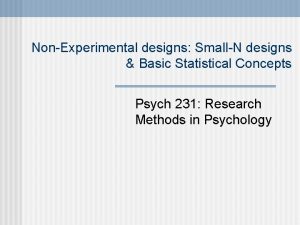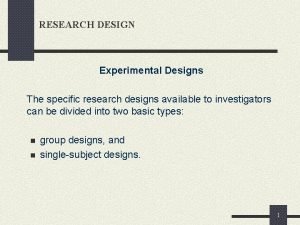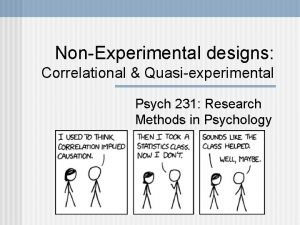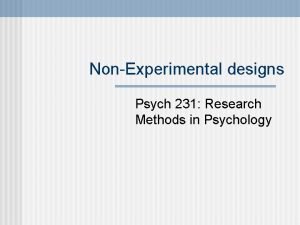Research Designs Demonstrations vs Comparisons Experimental NonExperimental Designs





















- Slides: 21

Research Designs • Demonstrations vs. Comparisons • Experimental & Non-Experimental Designs • “IVs” and “DVs” • Can all causal RH: be tested ? ? • Between Group vs. Within-Group Designs

There are two basic ways of providing evidence to support a RH: -- a “demonstration” and a “comparison” • a demonstration involves using the treatment and showing that the results are “good” • a comparison (an experiment) involves showing the difference between the results of the treatment and a “control” • lots of commercials use demonstrations • We washed these dirty clothes in Tide -- see how clean !!! • After taking Tums her heartburn improved !!! • He had a terrible headache. After taking Tylenol he’s dancing with his daughter! • The evidence from a demonstration usually meets with the response -- “Compared to what ? ? ” • a single demonstration is a “implicit” comparison • “doesn’t this wash look better then yours ? ” • “did your last heartburn improve this fast ? ” • “didn’t your last headache last longer than this ? ” • explicit comparisons are preferred !!!

When testing causal RH: we must have a “fair comparison” or a “well-run Experiment” that provides • init eq of subject variables & ongoing eq of procedural variables • For example what if our experiment intended to show that Tide works better compared… Really dirty light-colored clothes washed in a small amount of cold water for 5 minutes with a single rinse -- using Brand-X vs. Barely dirty dark-colored clothes washed in a large amount of hot water for 25 minutes with a double rinse -- using Tide What is supposed to be the “causal variable” that produces the difference in the cleanness of the two loads of clothes? Can you separate the initial and ongoing equivalence confounds ? Initial Equivalence confounds Ongoing Equivalence confounds • “dirtyness” of clothes • color of clothes • amount & temperature of water • length of washing • single vs. double rinse

Research Designs True Experiment • True Experiments If “well-done, ” can be used to test causal RH: -- alternative hyp. are ruled out because there are no confounds !!! Non-Experiments No version can be used to test causal RH: -- can’t rule out alternative hyp. Because there are confounds !! • • random assignment of individual participants by researcher before IV manipulation (provides initial equivalence - subject variables - internal validity) treatment/manipulation performed by researcher (provides temporal precedence & ongoing equivalence - internal validity) good control of procedural variables during task completion & DV measurement (provides ongoing equivalence - internal validity) Quasi-Experiment • • • no random assignment of individuals (but perhaps random assignment of intact groups) treatment/manipulation performed by researcher poor or no control of procedural variables during task, etc. Natural Groups Design also called Concomitant • • • Measures or Correlational Design no random assignment of individuals (already in “IV groups”) no treatment manipulation performed by researche (all variables are measured) -- a comparison among participants already in groups no control of procedural variables during task, etc.

Words of Caution About the terms “IVs”, “DVs” & causal RH: s. . . You might have noticed that we’ve not yet used these terms. . • Instead we’ve talked about “causal variables” and “effect variables” -- as you probably remember. . – the Independent Variable (IV) is the “causal variable” – the Dependent Variable (DV) is the “effect variable” • However, from the last slide, you know that we can only say the IV causes the DV if we have a true experiment (and the internal validity it provides) – initial equivalence (control of subject variables) • random assignment of participants – ongoing equivalence (control of procedural variables) • experimenter manipulates IV, measures DV and controls all other procedural variables

The problem seems to come from there being at least three different meanings or uses of the term “IV”. . . 1 “the variable manipulated by the researcher” • it’s the “IV” because it is “independent” of any naturally occurring contingencies or relationships between behaviors • the researcher, and the researcher alone, determines the value of the IV for each participant 2 “the grouping, condition, or treatment variable” 3 “the presumed causal variable in the cause-effect relationship” In these last two, both the “IV” & “DV” might be measured !!! So… • you don’t have a True Experiment. . . • no IV manipulation to provide temporal precedence • no random assignment to provide init. eq. for subject vars • no “control” to provide onging eq. for procedural variables • … and can’t test a causal RH:

IVs “vs” Confounds Both IVs and Confounds are “causal variables” !!! • variables that may cause (influence, etc. ) scores on the DVs What’s the difference ? ? ? The IV is the intended causal variable in the study! We are trying to study if & how much the IV influences the DV ! A confound interferes with our ability to study the causal relationship between the IV & the DV, because it is another causal variable that might be influencing the DV. If the IV difference between the conditions is confounded, then if there is a DV difference between the conditions, we don’t know if that difference was caused by the IV, the confound or a combination of both !!!!

So… Can all causal RH: be tested ? ? ? The short version is … Not all causal RH: can be tested because technology, ethics, and/or resources can prevent us from conducting a properly run True Experiment with random assignment of individual participants, IV manipulation and control of ongoing equivalence. The complete answer has three parts: Part #1: What is required to test a causal RH: ? ? To test a Causal RH: you must have a properly run True Experiment !! You must have … • Random assignment of individual participants to IV conditions by the researcher before manipulation of the IV • Manipulation of the IV by the researcher • Control of the experimental procedure so that there are no ongoing equivalence confounds

So… Can all causal RH: be tested ? ? ? continued Part #2: We can’t always run a True Experiment Not all IVs can be randomly assigned and manipulated !! • Sometimes we are prevented from randomly assigning individuals to specific conditions of the IV • Sometimes we are unable to manipulate the IV – that is to “produce” the value of the IV that each participant has Part #3: Three things may prevent us from performing RA & manipulation of some IVs Insufficient technology - some things we “can’t RA & manipulate” ! Ethics - some things we’ve decided “shouldn’t RA & manipulate” ! Resources -- tech. exists to perform the study and it is “allowed, ” but you “can’t afford to RA & manipulate”

So, you gotta have a True Experiment for the results to be causally interpretable? But, does running a “True Experiment” guarantee that the results will be causally interpretable? What are the elements of a True Experiment? ? Random Assignment if Individuals to IV conditions by the researcher before manipulation of the IV Supposed to give us initial equivalence of measured/subject variables. Manipulation of the IV by the researcher Supposed to give us temporal precedence & help control ongoing equivalence of manipulated/procedural variables All other procedural variables are constants or RAed control variables Supposed to give us control ongoing equivalence of manipulated/procedural variables

If only True Experiments can be causally interpreted, why even bother running non-experiments? 1 st Remember that we can’t always run a true experiment ! • Lots of variables we care about can’t be RA & manip – gender, family background, histories and experiences, personality, etc. • Even if we can RA & manip, lots of studies require long-term or field research that makes ongoing equivalence (also required for causal interp) very difficult or impossible. • We would greatly limit the information we could learn about how variables are related to each other if we only ran studies that could be causally interpreted.

If only True Experiments can be causally interpreted, why even bother running nonexperiments? Cont… 2 nd We get very useful information from non-experiments ! • True, if we don’t run a True Experiment, we are limited to learning predictive information and testing associative RH: • But associative information is the core of our understanding about what variables relate to each other and how they relate • Most of the information we use in science, medicine, education, politics, and everyday decisions are based on only associative information – and things go pretty well! • Also, designing and conducting True Experiments is made easier if we have a rich understanding of what variables are potential causes and confounds of the behavior we are studying

Between Groups vs. Within-Groups Designs Between Groups • also called Between Subjects or Cross-sectional • each participant is in one (& only one) of the treatments/conditions • different groups of participants are in each treatment/condition • typically used to study “differences” -- when, in application, a participant will usually be in one treatment/condition or another Within-Groups Designs • also called Within-Subjects, Repeated Measures, or Longitudinal • each participant is in all (every one) of the treatment/conditions • one group of participants, that group completes every condition • typically used to study “changes” -- when, in application, a participant will usually be moving from one condition to another

Between Groups Design Paper Hw Computer Hw Within-Groups Design Paper Hw Computer Hw Pat Glen Pat Sam Sally Sam Kim Kishon Kim Lou Phil Lou Todd Rae Todd Bill Kris Bill Different participants in each treatment/condition All participants in each treatment/condition

Research Designs Putting this all together -- here’s a summary of the four types of designs we’ll be working with. . . True Experiment • w/ “proper” RA/CB - init eqiv • manip of IV by researcher Between Groups (dif parts. in each IV condition) Within-Groups (each part. in all IV conditions) Results might be causally interpreted -- if good ongoing equivalence Non-experiment • no or poor RA/CB • may have IV manip Results can not be causally interpreted

Four versions of the same study … which is which? • Each participant in our “object identification study” was BG Non asked to select whether they wanted to complete the “visual” or the “auditory” condition. • Each participant in our “object identification study” WG Exp completed both the “visual” and the “auditory” conditions in a randomly chosen order for each participant. • Each participant in our “object identification study” was BG Exp. randomly assigned to complete either the “visual” or the “auditory” condition. • Each participant in our “object identification study” completed first the “visual” and then the “auditory” condition. WG Non

Between Groups True Experiment Untreated Population participant Treated Population selection participant pool random participant Not-to-get-Tx group no treatment Untreated group assignment to-get-Tx group treatment Treated group Rem -- samples & “groups” are intended to represent populations

Within-Groups True Experiment Untreated Population participant Treated Population selection Each participant represents each target population, in a counterbalanced order participant pool random participant assignment Not all treatments can be used in a WG design – only those that “wear off” can be counter -balanced! 1/2 of subjects Untreated Treated 1/2 of subjects Treated Untreated

Between Groups Non-experiment Untreated Population participant selection Untreated group Treated Population participant selection Treated group The design has the external validity advantage that each subject REALLY is a member of the population of interest (but we still need a representative sample) The design has the internal validity disadvantages that. . . • we don’t know how participants “end up” in the populations • no random participant assignment (no initial equivalence) • we don’t know how the populations differ in addition to the treatment per se • no control of procedural variables (no ongoing equivalence)

Within-Groups Non-experiment Paper Hw Population participant whole changes population to Comp Hw Comp. Hw Population selection Paper Hw group Computer Hw group The design has the external validity advantage that each subject REALLY is a member of each population of interest (but we still need a representative sample) The design has the internal validity disadvantages that. . . • we don’t know how the populations differ in addition to the treatment per se • no control of procedural variables (no ongoing equivalence)

There is always “just one more thing”. . . Sometimes there is no counterbalancing in a Within-groups design, but there can still be causal interpretation… • A good example is when the IV is “amount of practice” with “ 10 practice” and a “ 50 practice” conditions. • There is no way a person can be in the 50 practice condition, and then be in the 10 practice condition • Under these conditions (called a “seriated IV”), what matters is whether or not we can maintain “ongoing equivalence” so that the only reason for a change in performance would be the increased practice • The length of time involved is usually a very important consideration • Whether the study is conducted in the laboratory or the field is also important Which result would you be more comfortable giving a causal interpretation? • When we gave folks an initial test, 10 practice and then the test again, we found that at their performance went up! • When we gave folks an initial assessment, 6 months of once-a-week therapy and then the assessment again, their depression went down!
 Experimental vs nonexperimental
Experimental vs nonexperimental Experimental vs non experimental research
Experimental vs non experimental research Quasi-experimental research designs
Quasi-experimental research designs Quasi-experimental research designs
Quasi-experimental research designs Experimental vs non experimental
Experimental vs non experimental Ornamental horticulture demonstrations ideas
Ornamental horticulture demonstrations ideas If a ruby is heated it temporarily lose its color
If a ruby is heated it temporarily lose its color Research paradigm example
Research paradigm example Research instrument in experimental research
Research instrument in experimental research Experimental vs non experimental
Experimental vs non experimental Experimental vs non experimental
Experimental vs non experimental Key principles of experimental design
Key principles of experimental design Matched pairs vs block design
Matched pairs vs block design Meaning of research design
Meaning of research design Basic principles of experimental design
Basic principles of experimental design Characteristics of experimental research design
Characteristics of experimental research design Non experimental research design
Non experimental research design Disadvantage of quasi experiment
Disadvantage of quasi experiment Ano ang basic research
Ano ang basic research Mini research example
Mini research example Tujuan randomisasi penelitian
Tujuan randomisasi penelitian Experimental research design
Experimental research design








